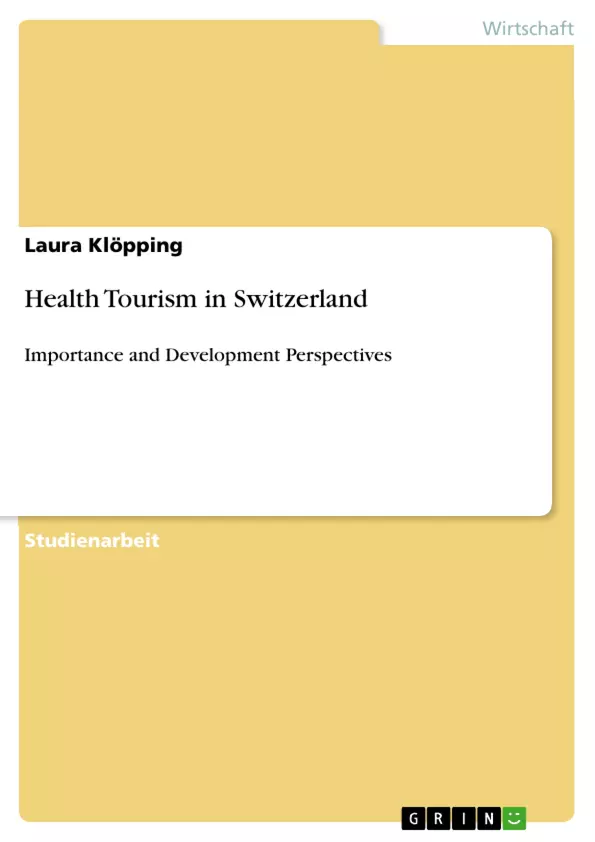Since the 1980s, the European health tourism is in a phase of complete change. Starting with cures, we are nowadays confronted with a wide range of wellness tourism offers. Today not only health resorts, spas or wellness hotels can be found on the market. Also theme parks, hotel chains and club destinations draw closer to health oriented tourism.
Switzerland does really have huge possibilities within the health tourism sector and the tourism sector in general. Its most important strengths are landscape, alpine and Mediterranean climate, a great range of offers (summer/winter), manageable cities with attractive cultural offers, cleanliness, a good infrastructure and a central position within Europe. But there are also some considerable market weaknesses, that have to be regarded: high-priced image, unfavorable foreign exchange rates, treacherous weather, high investment needs and missing hospitality and openness.
However, the very positive image as a holiday country, a sound nature and high reputation in the medical and also political sector (medical infrastructure, security, stability, protected privacy) give Switzerland ideal assumptions for the international competition.
Inhaltsverzeichnis
- Switzerland and Tourism.
- Health Tourism..
- Healing..
- Palliation..
- Prevention...
- Lifestyle….……………………
- Health Tourism in Switzerland
- Wellness Hotel Industry.
- Elements and Demand...
- Factors of Success and Requirements of the STV.
- Importance of Wellness for the Hotel Industry.
- Swiss Wellness Hotels, Quality Seals and Competition.
- Medical Tourism..
- Spiritual Tourism.........
- Cure Tourism
- Sports Tourism........
- Wellness Hotel Industry.
- Economical Relevance...
- Conclusion.......
- Outlook
- Sources
Zielsetzung und Themenschwerpunkte
Der Fokus dieser Arbeit liegt auf der Bedeutung des Gesundheitstourismus in der Schweiz sowie auf dessen Entwicklungsperspektiven. Die Arbeit analysiert verschiedene Bereiche des Gesundheitstourismus, darunter Wellness-, Medical-, Spiritual-, Cure- und Sporttourismus.
- Entwicklung und Bedeutung des Tourismus in der Schweiz
- Definition und Kategorien des Gesundheitstourismus
- Analyse verschiedener Arten des Gesundheitstourismus in der Schweiz
- Ökonomische Bedeutung des Gesundheitstourismus in der Schweiz
- Zukünftige Entwicklungen und Trends im Schweizer Gesundheitstourismus
Zusammenfassung der Kapitel
Kapitel 1 gibt einen Überblick über die Schweiz als Tourismusland, einschließlich ihrer geografischen Lage, ihrer Bevölkerung und ihrer Bedeutung als Wirtschaftsfaktor. Kapitel 2 definiert und kategorisiert den Gesundheitstourismus, wobei verschiedene Bereiche wie Heilung, Palliation, Prävention und Lifestyle-Tourismus vorgestellt werden. Kapitel 3 widmet sich dem Gesundheitstourismus in der Schweiz und untersucht die Wellness-Hotelindustrie, den Medical-, Spiritual-, Cure- und Sporttourismus. Kapitel 4 analysiert die ökonomische Bedeutung des Gesundheitstourismus in der Schweiz.
Schlüsselwörter
Die Arbeit befasst sich mit den folgenden Schlüsselbegriffen und Schwerpunkten: Gesundheitstourismus, Wellness, Medical Tourism, Spiritual Tourism, Cure Tourism, Sport Tourism, Schweiz, Tourismusindustrie, Wirtschaftsfaktor, Entwicklungsperspektiven.
- Quote paper
- Laura Klöpping (Author), 2012, Health Tourism in Switzerland, Munich, GRIN Verlag, https://www.grin.com/document/189278



